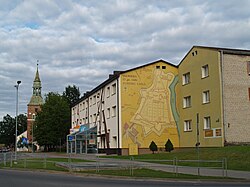Valmiera
| Valmiera | |||
|---|---|---|---|
| City | |||

Town centre with St. Simon's Church behind
|
|||
|
|||
| Location in Latvia | |||
| Coordinates: 57°33′N 25°24′E / 57.550°N 25.400°ECoordinates: 57°33′N 25°24′E / 57.550°N 25.400°E | |||
| Country |
|
||
| Town rights | 1323 | ||
| Government | |||
| • Mayor | Jānis Baiks | ||
| Area | |||
| • Total | 18.18 km2 (7.02 sq mi) | ||
| Population | |||
| • Total | 24,818 | ||
| • Density | 1,365/km2 (3,540/sq mi) | ||
| Time zone | EET (UTC+2) | ||
| • Summer (DST) | EEST (UTC+3) | ||
| Postal code | LV-4201 LV-4202 LV-4204 | ||
| Calling code | +371 642 | ||
| Number of city council members | 13 | ||
Valmiera (![]() pronunciation ; German: Wolmar) is the largest city of the historical Vidzeme region, Latvia, with a total area of 18.1 square kilometres (7 square miles). It is the center of the Valmiera District. As of 2002, Valmiera had a population of 27,323, and in 2017 – 24,818.
pronunciation ; German: Wolmar) is the largest city of the historical Vidzeme region, Latvia, with a total area of 18.1 square kilometres (7 square miles). It is the center of the Valmiera District. As of 2002, Valmiera had a population of 27,323, and in 2017 – 24,818.
It lies at the crossroads of several important roads, 100 kilometres (62 miles) to the north-east from Riga, the capital of Latvia, and 50 km (31 mi) south of the border with Estonia. Valmiera lies on both banks of the Gauja River.
Valmiera and its surroundings have been one of the longest-inhabited regions of Latvia. Archeological evidence indicates the site was inhabited 9,000 years ago. In 1224 after partition of Tālava trade roads along the Gauja river became property of Livonian Brothers of the Sword who erected a castle which is today known as Valmiera Castle. After the Battle of Saule in 1236 Valmiera Castle and nearby lands became the property of the newly established Livonian Order.
Valmiera was first mentioned as a town in a chronicle dating back to 1323. The actual founding of the town probably occurred at least 40 years earlier when the master of the Livonian Order Wilken von Endorp constructed a castle (Wolmar) and Catholic church on the banks of the river Gauja. Valmiera was a member of the Hanseatic League from the 14th–16th centuries. Involvement in the Hansa brought significant trade and movement into the town’s life. During the 14th-16th centuries several regional assemblies (landtags) were held in Valmiera. After the Livonian War in 1583 Valmiera was heavily devastated and was incorporated into the Duchy of Livonia as part of Wenden Voivodeship. After the Polish-Swedish war in 1622 Valmiera was managed by the Lord High Chancellor of Sweden Axel Oxenstierna.
...
Wikipedia



